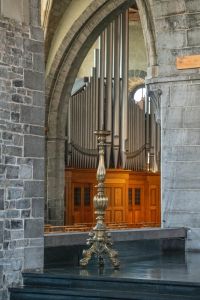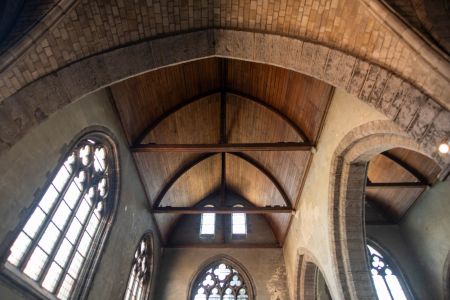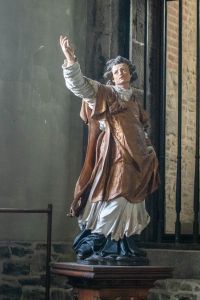Church | XIII | Gothic | Catholic Church


Map
Opening hours
01 April - 31 October
Mon 9.00 - 18.00
Tue 9.00 - 18.00
Wed 9.00 - 18.00
Thu 9.00 - 18.00
Fri 9.00 - 18.00
Sat 9.00 - 18.00
Sun 9.00 - 18.00
01 November - 31 March
Mon 9.00 - 17.00
Tue 9.00 - 17.00
Wed 9.00 - 17.00
Thu 9.00 - 17.00
Fri 9.00 - 17.00
Sat 9.00 - 17.00
Sun 9.00 - 17.00
Religious offices
from Monday till Friday : 8 am
Saturday 5 pm
Description
Saint-Brice church dates back to the 12th century. Unfortunately it is just a few hundred metres from the railway station, so was heavily bombed between 1940 and 1945. Its rebuilding by the architect Simon Brigode was completed in 1954.
It is basically a Romanesque building with some gothic features. It is on a small square amid gardens and roofed with old style flat red tiles. It has a square 15th century tower with nave and transepts topped by a second tower.
Inside, the quality of the light gives an impression of space and luminosity encouraging meditation. The choir is in the form of a triple hall and the ceiling is in wood. Among the ornaments are large candle holders, old statues of saints and more recent ones by the Tournai artist Nelly Mercier.The altar, the tabernacle and the surprising baptismal font on the sides of which are depicted a sensual Eve, Adam and the hand of God are the works of the sculptor, George Gerard. A painting of the Grand Duchess Isabelle giving her jewels to Our Lady of Hal is by Gaspard de Crayer.
Photos
Media
Remarkable elements
Works by Georges Grard (1901-1984)
The bronze altar, tabernacle door and baptismal font were created in 1966-1971 by Tournai sculptor Georges Grard.
The altar represents humanity saved by the sacrificial Christ: the fish, symbols of the first Christians, frame his face printed on Véronique's veil and his crucified hands.
More discreetly charged with meaning, the tabernacle is decorated with the concentric forms of a flower of life surrounding the consecrated host, the symbol of God the Creator.
A superb baptismal font showing the hands of the creator of the universe, with its stars, its natural beauties and its perfect flowering, the human being, represented by Adam and Eve.
Article by Francis Vande Putte
Archduchess Isabella offering jewels to Our Lady of Hal
Painting by Gaspard de Crayer (1584-1669), known for his many altarpieces, counter-reformist paintings and portraits. He worked in the main towns of Flanders, where he contributed to the spread of Rubens' style, and was considered the court painter of the Archdukes Albert and Isabella.
This painting was not produced for Saint-Brice church, but belonged to the old paintings of the City of Tournai, a collection donated by Verbelen. After the bombing disaster of 1940, it was donated - and not simply 'deposited', it seems - by the town to the church (parish) of Saint-Brice as a contribution to the reconstruction effort after the war damage.
There has always been a Tournais pilgrimage to Our Lady of Hal. The existence of this pilgrimage may explain why the City of Tournai donated this painting to the parish of St-Brice.
Statues by Tournai artist Nelly Mercier (1905-1998)
The works by Nelly Mercier, very much in the style of the 1950s and 1960s, are largely linked to the history of the district and the church. There are statues of Mary, Saint Joseph, Saint Brice, Saint Mary Magdalene, a statue of a saint wearing a Sacred Heart (the new Sacred Heart parish, on the other side of the station, had just been created before the 1st World War) and others that are perhaps related to old paintings and statues that appeared in the parishes on the Left Bank.
Mary and Joseph surrounding Jesus
Painting by Cornelis Cels (or Celis), a Belgian neo-classical painter (1778-1859). Pupil of the painter P.J. Denis (nl), then in Brussels of André Corneille Lens. In 1800, he left for Paris and joined the studio of Baron Antoine-Jean Gros.
The Musée de Tournai has a work by him that is rarely shown because it permanently decorates the chapel of the Athénée Bara: 'Jésus parmi les Docteurs'.
Equestrian sculpture of Saint Hermes
This sculpture is thought to date from the late 15th or early 16th century. This valiant Roman horseman is invoked against headaches, madness and the powers of evil. Saint Hermes is highly honoured in Ronse, and is said to cure local madmen but leave the people of Ronse as they are.
The statue was one of the parish saints often carried in the Great Procession of Tournai, probably because the canopy that once crowned the Blessed Sacrament was lent by the church of Ronse.
The organ
Neo-classical organ built in 1962 by the Maison Delmotte of Tournai. This instrument replaces the organ built by Pierre Schyven, which was destroyed during the bombardment of May 1940.
Source : Francis Vande Putte


































